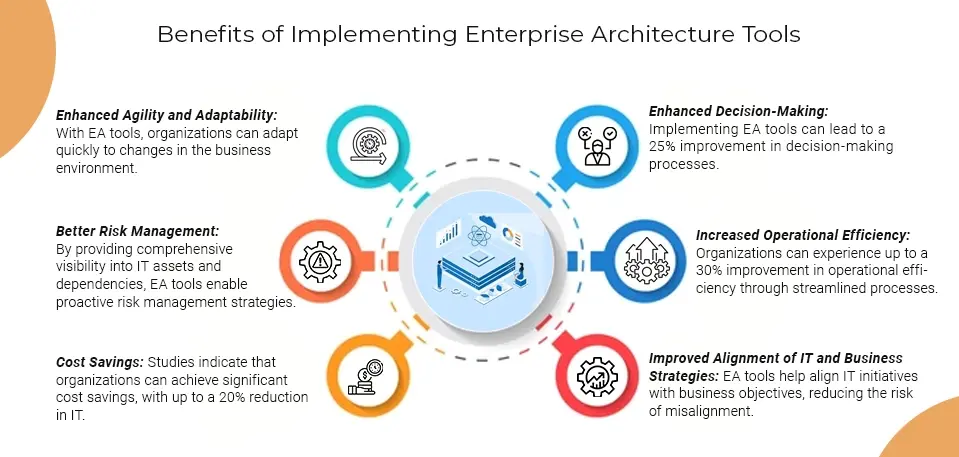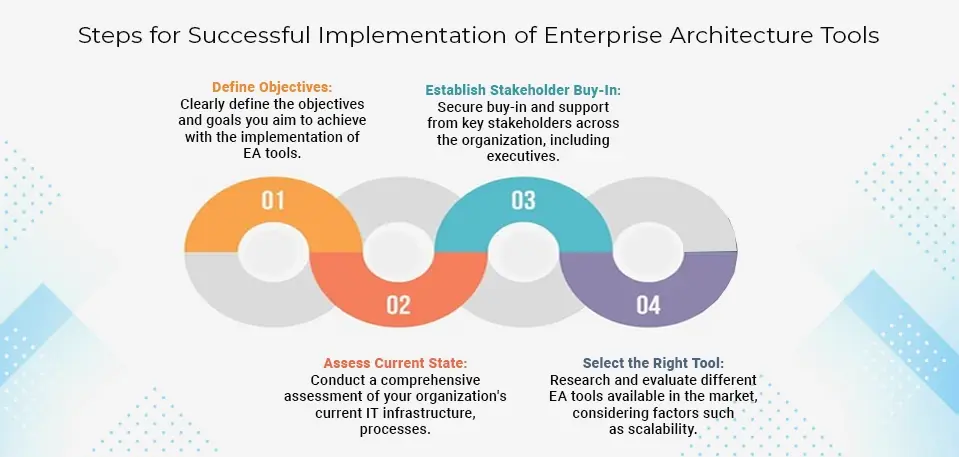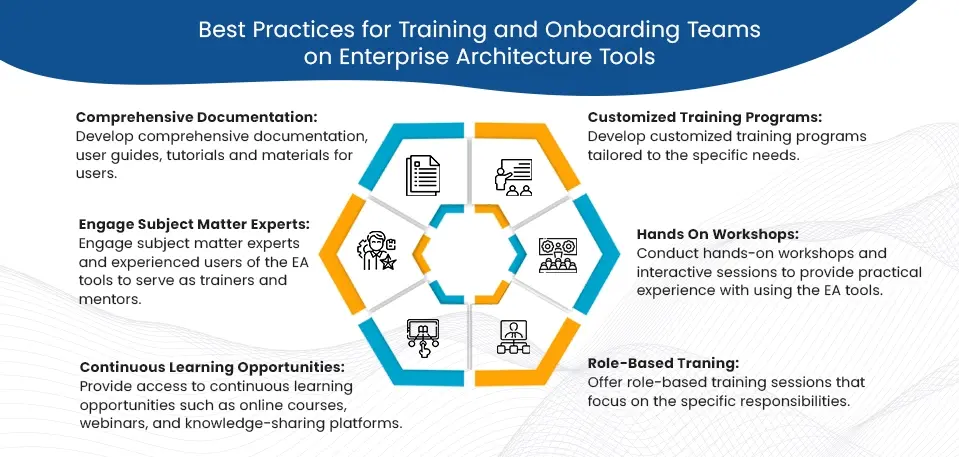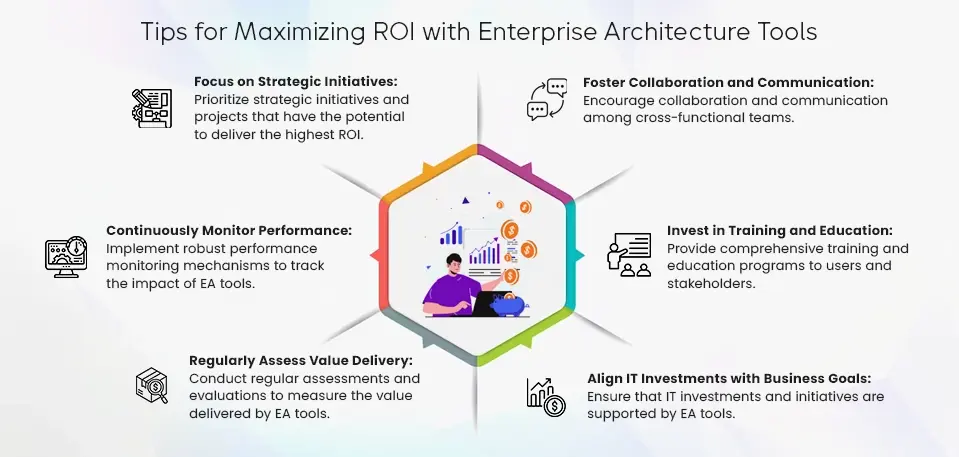Table of Contents
Enterprise architecture is widely used by large enterprises to direct daily operations and manage digital transformation projects. However, tools for enterprise architecture (EA) are essential for helping businesses gain a cohesive and thorough understanding of their information, IT assets, procedures, and strategy. Enterprise Architecture Tools and Solutions provide a comprehensive viewpoint that enables decision-makers to detect possible inefficiencies more efficiently, guarantee that IT projects and business goals are aligned, and eventually propel digital transformation. The global enterprise architecture tools market is projected to reach over $3.5 billion by 2025, reflecting the growing demand for advanced solutions to address business complexities.
The best enterprise architecture tools enable decision-makers to create better plans rather than just keeping track of an organization’s present state. Over 60% of organizations cite enterprise architecture as a critical factor in driving digital transformation initiatives and open source enterprise architecture tools achieving strategic goals in today’s digital era. In this blog post, we’ll explore the leading enterprise architecture tools. But first, let’s delve into a deeper understanding of EA tools and explore their benefits to your organization.
What Are Enterprise Architecture Tools?
Software programs known as enterprise architecture tools are made to help businesses manage the complexity of their IT infrastructure and match it with their goals. However, these technologies offer an organized framework for gathering, examining, and displaying different organizational elements, including information, IT assets, procedures, and strategy.
Enterprise architecture tools are primarily meant to provide a thorough picture so that decision-makers may make well-informed decisions regarding IT investments and strategies. Moreover, research indicates that companies leveraging enterprise architecture tools experience up to a 25% increase in operational efficiency, resulting from improved process visibility and optimization. Transparency, streamlined communication, and overall IT operations efficiency are all supported by these solutions.
To put it briefly, enterprise architecture tools are invaluable tools for businesses trying to maximize their IT environment. Improve strategic planning, and make sure their technological endeavours are in perfect harmony with overarching company objectives.

Key Features Of Enterprise Architecture Tools
From advanced visualization to automation, these features collectively empower custom software development services to navigate the intricacies of their IT landscape with precision and strategic foresight.
1. Comprehensive Visualization
Enterprise architecture tools offer advanced visualization capabilities, providing a clear and detailed representation of an organization’s architecture. This feature enables users to understand complex relationships between different components, fostering better decision-making.
2. Modeling Capabilities
These tools have robust modeling features, allowing users to create detailed representations of business processes, IT systems, and data structures. This modeling capability aids in designing and optimizing the organization’s architecture.
3. Centralized Repository and Data Storage
Enterprise architecture tools manage a centralized repository to store architecture artefacts and associated metadata, including attributes, descriptions, and version history securely. However, digital transformation in healthcare with repository functions as the definitive source of truth for all architecture-related information.
4. Collaboration and Communication
Enterprise architecture software tools facilitate collaboration among team members by offering communication channels and sharing functionalities. This fosters effective teamwork, ensuring organizational stakeholders can contribute to and benefit from architectural insights.
5. Alignment with Business Objectives
One of the primary features of these tools is their ability to align IT strategies with overall business goals. Furthermore, they provide a framework for ensuring that technology initiatives directly contribute to achieving organizational objectives, enhancing the strategic value of IT.
6. Automation and Analysis
Enterprise architecture software tools often incorporate automation features, streamlining data collection processes and generating customizable reports. This saves time and allows for a more in-depth analysis of the enterprise software development companies‘ architecture. Furthermore, automation aids in connecting IT growth to business outcomes, supporting informed decision-making.
Modern enterprise architecture tools are indispensable assets for IT teams in the complexities of IT infrastructure. However, they tackle the intricacies of aligning IT strategies with business goals and offer crucial support in overcoming the challenges of the dynamic and evolving tech environment. Let’s explore how these contemporary EA tools contribute to hire software developers.
Shape Tomorrow’s Solutions. Explore Enterprise Architecture Tools for Today’s Challenges.
How Modern Enterprise Architecture Tools Support IT Teams
The demand for enhanced enterprise architecture is high in today’s tech-driven world. This architecture should adeptly align IT strategies with custom software development companies in USA goals, especially with the prevalent emphasis on cloud services and products. For IT teams to excel, having the right tools is key.
Enterprise architects need tools that make it fully transparent and simplify complex enterprise architecture topics for everyone involved. However, a good enterprise architecture tool offers visibility, improves usability, and encourages collaboration among various team members. Unlike conventional approaches, these tools enable IT teams to seamlessly map, analyze, and optimize the complex interplay of systems and processes that constitute the backbone of modern enterprises.
With a data-driven approach and real-time insights, these tools help enterprise architects create optimal conditions for ongoing changes. Moreover, through its automated processes like data gathering and customizable reporting, enterprise architects and custom software development consulting teams discover a simplified pathway to link IT growth directly to business outcomes. However, this streamlined approach facilitates a more efficient and effective integration of IT initiatives with overarching business objectives.
Moreover, integrating advanced analytics and automation within these tools enhances efficiency, allowing IT professionals to focus on strategic initiatives rather than getting entangled in routine operational intricacies.
Key Advantages Of Using Enterprise Architecture Tools
Enterprise Architecture (EA) tools offer a multitude of advantages for organizations navigating the complexities of modern business environments:
1. Enhanced Visibility and Understanding
Enterprise Architecture tools provide a comprehensive view of an organization’s IT landscape, helping stakeholders understand the interrelationships among various components. However, this visibility facilitates better decision-making by enabling a holistic comprehension of the entire enterprise software development companies.
2. Improved Strategic Alignment
These tools help align IT strategies with overall business objectives. Organizations can ensure that their technology investments directly contribute to the overarching strategic vision by mapping IT assets and processes to business goals.
3. Efficient Resource Management
EA tools assist in optimizing resource allocation by identifying redundancies, inefficiencies, and gaps within the IT infrastructure. However, this leads to more effective use of resources, reducing costs and enhancing operational efficiency.
4. Facilitates Change Management
EA tools are vital in managing change in a rapidly evolving business landscape. Moreover, they provide a structured approach for assessing the impact of proposed changes, enabling organizations in digital transformation in healthcare to implement modifications smoothly while minimizing disruptions.
5. Risk Management and Compliance
Enterprise Architecture tools aid in identifying and mitigating risks associated with IT systems. They also help ensure regulatory compliance by providing insights into how IT processes adhere to industry standards and regulations.
6. Informed Decision-Making
With the help of analytics and modeling capabilities, EA tools empower decision-makers with data-driven insights. Subsequently, this enables informed decision-making regarding technology investments, upgrades, and other strategic initiatives of many best custom software development companies.
7. Faster Solution Deployment
By offering a clear understanding of existing systems and dependencies, EA tools expedite the deployment of new solutions. However, this agility is crucial in today’s competitive landscape, where the rapid implementation of innovative technologies can provide a competitive edge.
8. Supports Digital Transformation
EA tools are pivotal in orchestrating this change as organizations undergo digital transformation. They help integrate new technologies seamlessly and align digital initiatives with the overall enterprise architecture.
In conclusion, adopting Enterprise Architecture tools is instrumental in driving efficiency, managing complexity, and ensuring that your organization’s IT infrastructure remains agile and aligned with its strategic goals.

List of Top 13 Enterprise Architecture Tools
Let’s delve into a comprehensive exploration of 13 leading enterprise architecture tools.
1. Zluri
Given that the SaaS stack constitutes a pivotal element of your enterprise architecture, it often proves intricate to manage and monitor effectively. This is precisely where Zluri comes into play. Boasting the world’s largest collection with over 250,000 SaaS apps, Zluri employs five distinct discovery methods to comprehensively identify every SaaS application within your enterprise software development services providers.
These methods encompass Single Sign-On (SSO), integration with financial and expense management systems, and direct integration with apps, desktop agents, and browser agents.
Zluri’s ultimate goal is to eradicate shadow IT by providing a unified platform for managing your company’s SaaS applications. The platform has features designed to address and resolve SaaS-related issues, efficiently manage SaaS apps, and offer a comprehensive overview of your SaaS infrastructure. However, Zluri empowers you to take command of your organization’s SaaS ecosystem from a singular, centralized location.
Key Features
- Unified Management: Zluri provides a centralized platform for managing all aspects of your SaaS architecture and operations. This tool offers a unified interface for efficient and holistic management, from user access and permissions to subscription renewals and compliance for custom software development companies in USA.
- Real-Time Monitoring: Keep a vigilant eye on your SaaS landscape with Zluri’s real-time monitoring capabilities. However, to gain insights into usage patterns, performance metrics, and potential security risks to ensure optimal operation and data protection.
2. Avolution’s ABACUS
ABACUS, crafted by Avolution, stands as a beacon for custom software development services seeking a clear route to cost savings, growth, and business outcome-driven enterprise architecture (EA). This versatile tool is not just a solution; it’s an enabler of cloud-based collaboration, supporting remote work and digital strategy to meet the evolving needs of modern businesses.
ABACUS provides a cloud-based collaboration platform that aligns seamlessly with remote work demands and digital strategy. This ensures that teams can collaborate effectively, irrespective of geographical location. Leveraging advanced technologies, ABACUS incorporates algorithms and machine learning to accelerate calculations and analysis. Moreover, this empowers users with powerful insights, enabling informed and swift decision-making.
The tool specializes in building EA Roadmaps, offering a structured approach to navigating the complexities of both IT and business landscapes. This feature enhances strategic planning and decision-making.
Key Features
- Data Management with Flexibility: ABACUS allows users to import, export, integrate, and automate data management. This flexibility ensures that data-driven decisions are streamlined and aligned with organizational objectives.
- Enterprise Architecture and Business Strategy Management: Avolution’s ABACUS software suite seamlessly integrates enterprise architecture and business strategy management features. It facilitates quick data importation and centralization, model and roadmap creation, and analytics-driven report generation through rich visuals and dashboards.
3. Sparx Systems- Enterprise Architect
Sparx Systems Enterprise Architect stands as a comprehensive solution, providing full lifecycle modeling capabilities in a multi-user, graphical environment with integrated reporting. However, this dynamic tool empowers your teams to construct robust and maintainable systems, offering high-quality built-in reporting and documentation.
Sparx EA empowers users to generate custom reports and execute ad hoc queries against the model, providing flexibility in obtaining specific insights. The tool supports printing Model Diagrams in PDF and image formats, ensuring versatility in sharing and presenting visual representations. Furthermore, Sparx EA offers advanced search functionality, facilitating efficient navigation and retrieval of relevant information within the model.
Key Features
- Visualization through Reverse Engineering: Sparx EA enables the visualization of applications by supporting the reverse engineering of various software development languages, and database repository schemas and to include artificial intelligence in software development. This capability enhances your understanding of system architectures.
- Importing Frameworks and Library Code: The tool facilitates the import of frameworks and library code, allowing you to maximize the reuse and comprehension of your existing investments in codebases.
4. Capstera EA
Capstera’s Business Architecture Tool is your key to unravelling the intricacies of business architecture. This robust tool focuses on creating a comprehensive map that delineates the various facets of your business, providing invaluable insights into its structure and operations. However, the tool goes beyond mere documentation by integrating value and process maps, enabling you to clearly define and track the roles of different business sections.
It produces reports that delve into the intricacies of your business architecture, offering a comprehensive exploration beyond surface-level documentation. This tool empowers you to bridge the gap between custom software development outsourcing strategy and IT execution, providing a seamless connection that propels your business architecture initiatives forward.
Key Features
- Value and Process Maps: Capstera’s Business Architecture Tool excels in producing value and process maps, serving as a blueprint to explore and understand the intricate layers of your business architecture. However, these maps define roles and offer a visual narrative of how various elements interconnect within your organization.
- Strategic Summaries for Long-Term Planning: Unlock the power of strategic planning with Capstera. The tool facilitates the development of strategic summaries, providing insights that are essential for long-term planning. However, this forward-thinking approach ensures that your business architecture aligns seamlessly with your overarching strategic goals.
5. Ardoq
Ardoq, a powerful and data-driven platform, stands at the forefront of facilitating enterprise architecture and expediting digital transformation initiatives. However, this versatile tool is instrumental in planning, executing, and evaluating changes affecting key sectors such as personnel, projects, strategies, and organizational processes.
Further, it specializes in efficient application portfolio management and automation, ultimately contributing to improved business outcomes. Ardoq enhances risk, cost, and complexity modeling by incorporating automation and fostering company-wide engagement. However, the platform goes beyond mere data enrichment, providing actionable analyses that empower informed decision-making, ensuring a strategic and intelligent approach to business challenges.
Key Features
- Automation for Enhanced Efficiency: Ardoq integrates robust automation capabilities, simplifying the complexities of data collection and visualization. However, this feature significantly boosts operational efficiency, allowing seamless navigation through intricate datasets.
- Facilitating Team Interaction and Knowledge Sharing: Beyond automation, Ardoq fosters collaboration within teams by providing a platform for interactive knowledge sharing. This strengthens team dynamics and contributes to a more informed and aligned organizational approach.
6. Bizzdesign Horizzon
Bizzdesign Horizzon stands at the forefront of agile methodology in software development and enterprise architecture platforms. It is meticulously crafted to streamline business transformation and foster enhanced organizational collaboration. However, this dynamic platform is a catalyst for data-driven decision-making, offering comprehensive analytics and insights that empower enterprise software development services to navigate the complexities of the business landscape with clarity and precision.
Further, the platform strongly emphasizes governance and security, incorporating features such as single sign-on, audit trails, and compliance with industry security standards like ISO 27001 and SOC2. These measures are in place to safeguard your enterprise’s data and processes.
Key Features
- Intuitive Modeling Environment: Horizzon provides an intuitive modeling environment, simplifying intricate scenarios and empowering users to create strategy, architecture, and process models with ease.
- Dashboards and Current State Models: The platform offers dashboards and models that capture the current state of a business, serving as foundational elements for the creation of future state scenarios and detailed roadmaps.
7. Capsifi
Capsifi enterprise architecture tool revolutionizes how organizations manage and leverage their business knowledge. Focused on consolidating fragmented sources of information into a holistic and integrated whole, Capsifi transforms your business model into a dynamic, data-driven, enduring, interactive, and engaging strategic asset.
It aims to transform your business operating model into a fundamental strategic asset characterized by dynamism, data-driven insights, endurance, interactivity, and engagement.
The tool features an intuitive and customizable user interface, ensuring a user-friendly experience. However, this adaptability allows users to tailor the interface to their preferences, enhancing usability across various organizational roles. By making enterprise architecture accessible to some of the best custom software development companies, Capsifi empowers organizations to unlock the full potential of their strategic assets.
Key Features
- Assimilation and Alignment of Metadata: Capsifi’s EA tool excels at assimilating and aligning existing metadata within your organization. By consolidating disparate data sources, it ensures that your enterprise architecture is a cohesive representation of your business landscape.
- Simplified Visualization of Complex Components: Complex architectural components are made accessible and comprehensible through Capsifi’s platform. However, the tool simplifies the visualization of intricate elements, making it easier for stakeholders to understand and manage the complexities of the enterprise architecture.
8. Bee360
Bee360, an advanced enterprise architecture tool, emerges as a comprehensive solution for integrated and holistic management. This powerful tool seamlessly connects diverse areas such as strategy, enterprise architecture, project and portfolio management, and finance. By integrating these crucial domains, Bee360 empowers users to proactively design and transform organizations, ensuring that all impacts are consistently visible throughout the process.
Bee360 is designed for easy deployment and use, ensuring organizations can quickly harness its capabilities without extensive training or downtime. The platform features flexible dashboards that connect various processes associated with enterprise architecture. However, this adaptability enables users to tailor their experience to meet specific organizational needs.
Key Features
- Holistic Management: Bee360 provides a holistic approach to management, connecting strategy, enterprise architecture, project and portfolio management, and finance. This integration ensures a comprehensive understanding of the organizational landscape, fostering proactive design and transformation.
- Visibility into Impacts: The platform ensures that all impacts are visible throughout the transformation process. This transparency is crucial for making informed decisions and managing changes effectively.
9. LeanIX
LeanIX Enterprise Architecture is a pivotal platform providing organizations with a crystal-clear understanding of their business context and future trends. This comprehensive tool is designed for managing enterprise architecture and multi-cloud environments, empowering organizations to make swift, data-backed decisions regarding their IT strategies. Furthermore, gain real-time insights into your IT landscape, fostering an environment that boosts business capabilities, enhances productivity, and accelerates your digital transformation journey.
The platform offers transparency into your IT landscape and provides the tools necessary for efficient collaboration, automation, and strategic decision-making. Importantly, with LeanIX, organizations can navigate the complexities of their IT strategies with agility and confidence.
Key Features
- Accelerated Analysis and Transformation: LeanIX offers a robust feature set that accelerates the analysis and transformation of your IT landscape and business capabilities. Its core use cases include application rationalization, cloud migration, and ERP transformation, ensuring controlled cost management and heightened organizational agility.
- Customizable Dashboards and KPIs: The platform boasts a variety of customizable dashboards and Key Performance Indicators (KPIs) to keep stakeholders well-informed and engaged. However this feature provides a real-time snapshot of critical information for effective decision-making.
10. Mega-Hopex
The Hopex platform by Mega is your trusted EA tool for crafting a comprehensive digital representation of your enterprise. By seamlessly connecting business, IT, data, and risk perspectives within a single platform, Hopex empowers organizations. To derive actionable insights and foster collaboration among stakeholders. This holistic approach allows you to align your company’s business objectives efficiently and showcases the immediate business value of your projects.
Hopex provides robust support, making it user-friendly and accessible for all stakeholders. This support system enhances the user experience, making it easier for individuals across different roles to utilize the tool effectively.
Key Features
- Comprehensive Integration: Hopex seamlessly integrates into your digital ecosystem, ensuring a faster time-to-value for your enterprise architecture initiatives. This integration capability enables a smooth transition, allowing organizations to leverage existing digital assets and technologies.
- Unified Platform: Bringing together business, IT, data, and risk perspectives, Hopex provides a unified platform for creating a digital representation of your enterprise. This holistic view facilitates a deeper understanding of interdependencies, promoting strategic decision-making and alignment with organizational goals.
11. iServer
iServer, the flagship enterprise architecture solution by Orbus Software, is a robust tool designed. To forge a strategic partnership between enterprise architecture (EA) and the broader business landscape. With a foundation laid by Orbus Software, a pioneer in cloud software solutions since 2004, iServer is a reliable ally in guiding organizations through the intricate terrain of digital transformation.
With its seamless integration, flexibility, and commitment to rapid deployment, iServer empowers custom software development outsourcing to navigate the complexities of digital transformation with confidence and efficiency.
Key Features
- Seamless Integration with Existing Content: iServer is engineered to integrate seamlessly with familiar content formats such as Visio diagrams, Word documents, Excel spreadsheets, and PowerPoint presentations. This unique capability ensures a smooth transition of existing content into the iServer repository from day one, minimizing disruptions and maximizing productivity.
- Flexibility and Configurability: The platform offers high flexibility and configurability, allowing organizations to tailor the tool to their specific needs. This adaptability ensures that iServer aligns seamlessly with the unique requirements of each organization. Providing a customized and effective enterprise architecture management experience.
12. Planview
Planview Enterprise Architecture is a comprehensive solution trusted by over 4,500 customers globally, including 59 Fortune 100 companies. This robust enterprise architecture tool identifies high-potential ideas and transforms technology trends into innovative initiatives, driving profound business transformations.
Centralizing the capture, evaluation, and prioritization of ideas from customers, employees, and stakeholders, Planview Enterprise Architecture utilizes Ideation Management software. It facilitates a collaborative, web-based community, launching ideation campaigns that automate idea capture, collaboration, and voting. Emphasizing data privacy, security and artificial intelligence in software development. Planview adheres to rigorous standards and regulations to safeguard customer information, providing reliable service delivery.
Key Features
- Facilitating Business and Digital Transformations: Tailored to aid enterprises in enhancing time-to-market, predictability, and efficiency, Planview supports strategic initiatives to achieve intended business outcomes. The platform fosters a collaborative environment through visualizations, reports, and dashboards.
- Business Capability Planning: The tool includes business capability planning, aligning business capabilities with goals, and supporting continuous planning. This ensures a strategic alignment that enhances organizational agility.
13. Alfabet by Software AG
Alfabet, Software AG’s enterprise architecture management solution, empowers IT teams to master new technologies through digital transformation. In Software AG’s comprehensive digital stack, Alphabet enables organizations to detect conflicts, harness synergies, and drive innovation within their IT portfolios.
With its digital transformation prowess, integrated approach, and adaptable cloud functionality. Alfabet ensures that custom enterprise software development companies can strategically navigate and capitalize on the opportunities presented by new technologies.
Alfabet boasts a simple data model that allows extending and exchanging information with other applications across all levels and technologies. This simplicity ensures ease of use while offering scalability for future growth.
Key Features
- Digital Transformation Prowess: Alphabet empowers organizations to embark on a digital transformation journey by providing a lean, modern, and flexible enterprise architecture. This enables laser-focused investments, ensuring organizations can navigate and master new technologies in the ever-evolving digital landscape.
- Single View of Strategy and Operations: The platform facilitates a holistic approach by integrating source information and real-time performance data from any third-party software. This integration offers organizations a comprehensive view of their strategy and operations, fostering informed decision-making.

Assessing The Impact of Enterprise Architecture Tools on Business Processes
The adoption of enterprise architecture tools has become increasingly critical for organizations seeking to thrive in a competitive environment. According to recent studies, over 70% of companies consider enterprise architecture essential for achieving their business objectives, highlighting its growing importance in driving strategic initiatives and operational excellence.
With the proliferation of digital technologies and the complexity of modern business processes. Organizations face unprecedented challenges in managing and optimizing their operations. As businesses navigate the complexities of digital transformation and strive to meet evolving customer demands, the role of enterprise architecture tools in shaping organizational success cannot be overstated.
Enterprise architecture tools have demonstrated a substantial impact on business processes across industries. Here are some key findings:
1. Improved Efficiency
Studies indicate that organizations using enterprise architecture tools experience up to 30% improvement in process efficiency due to enhanced visibility and streamlined workflows.
2. Enhanced Decision-Making
Research shows that companies leveraging these tools report a 25% increase in data-driven decision-making, leading to more informed strategic choices and improved outcomes.
3. Cost Reduction
Adoption of enterprise architecture tools has been associated with significant cost savings, with reports suggesting a reduction of up to 20% in operational expenses through optimized resource allocation and waste reduction.
4. Accelerated Innovation
Organizations utilizing these tools witness a 35% increase in innovation speed, enabling them to adapt quickly to market changes and stay ahead of competitors in rapidly evolving industries.
5. Improved Customer Satisfaction
Studies reveal that businesses employing enterprise architecture tools observe a 40% enhancement in customer satisfaction levels, attributed to faster response times, personalized experiences, and improved service quality.
These findings underscore the transformative impact of enterprise architecture tools on business processes. Highlighting their role in driving efficiency, agility, and competitiveness in today’s dynamic marketplace.
Selecting The Best Enterprise Architecture Tools for Your Organization
Choosing the right enterprise architecture (EA) tools is paramount for organizations aiming to optimize their IT infrastructure and align it with blockchain software development company objectives. With numerous options available in the market, selecting the most suitable EA tools requires careful consideration and evaluation. Here, we delve into the key factors to consider when selecting the best enterprise architecture tools for your organization:
1. Understand Your Organization’s Needs
Begin by assessing your organization’s specific requirements, including scalability, integration capabilities, user experience, and alignment with business strategies.
2. Evaluate Vendor Reputation and Experience
Research and evaluate the reputation and experience of EA tool vendors. Consider factors such as customer reviews, case studies, and industry recognition to gauge the vendor’s track record and reliability.
3. Assess Features and Functionality
Evaluate the features and functionality offered by different EA tools. Look for tools that provide comprehensive solutions for architecture modeling, analysis, and visualization, tailored to meet your organization’s needs.
4. Consider Integration Capabilities
Assess the integration capabilities of EA tools with existing systems and applications. Choose tools that offer seamless integration to facilitate data exchange and interoperability across the organization.
5. Ensure Scalability and Flexibility
Select EA tools that can scale to accommodate your organization’s growing needs and evolving IT landscape. Forrester indicates that nearly 80% of organizations consider enterprise architecture essential for successful digital transformation initiatives, highlighting its strategic significance. Look for flexibility and customization options to adapt to changing business requirements.
6. Prioritize User Experience
User experience plays a crucial role in the successful adoption of EA tools. Choose tools with intuitive interfaces, interactive dashboards, and robust support documentation to enhance user adoption and productivity.
7. Evaluate Support and Training Options
Consider the vendor’s support and training offerings. Ensure that the vendor provides adequate support resources, including training programs, user forums, and technical assistance, to help your organization maximize the value of the EA tools.
8. Align with Long-Term Goals
Select EA tools that align with your organization’s long-term goals and vision for digital transformation. In a study published by IDC, organizations that effectively leverage enterprise architecture tools experience up to a 30% improvement in scalability. These tools enable businesses to streamline processes, optimize resources, and respond swiftly to market changes. Consider how the chosen tools can support future initiatives and adapt to emerging technologies and industry trends.
However, by considering these factors and conducting thorough research and evaluation, organizations can confidently select the best enterprise architecture tools that align with their strategic objectives and drive business success.
Implementing and Integrating Enterprise Architecture Tools Effectively
Implementing and integrating enterprise architecture (EA) tools effectively is crucial for organizations aiming to optimize their IT infrastructure and align it with business objectives. According to recent studies, organizations that effectively implement EA tools experience up to a 25% improvement in operational efficiency, resulting from enhanced visibility and streamlined workflows. Successful integration of EA tools also enables organizations to accelerate decision-making processes. However, reports indicate a 20% increase in data-driven decision-making capabilities.
The process of implementation and integration requires careful planning and execution. Importantly, research suggests that nearly 60% of organizations encounter challenges during the implementation phase, such as data migration issues, integration complexities, and resistance to change. Moreover, to overcome these challenges, organizations should prioritize clear communication, stakeholder engagement, and comprehensive training programs. However, by investing in effective implementation strategies and fostering a culture of collaboration, organizations can harness the full potential of EA tools to drive innovation, improve operational efficiency, and achieve strategic objectives in today’s dynamic business environment.
Furthermore, data from industry surveys highlights the importance of selecting the right enterprise architecture tools. Ensuring their seamless integration into existing systems. Over 70% of organizations cite integration challenges as a significant barrier to realizing the full benefits of EA tools. This underscores the critical need for robust integration strategies and alignment with organizational goals.
To address integration complexities, organizations should prioritize interoperability and compatibility when selecting EA tools. Solutions that offer flexible integration options and support industry-standard protocols can facilitate smoother integration processes and minimize disruption to existing workflows. Additionally, leveraging best practices and engaging with experienced implementation digital transformation companies in USA can streamline the integration journey and accelerate time to value.

Maximizing ROI and Business Value with Enterprise Architecture Tools
Maximizing ROI and business value with enterprise architecture (EA) tools is a strategic imperative for organizations seeking to optimize their IT investments and drive sustainable growth. Studies indicate that organizations that effectively leverage EA tools experience tangible benefits, including up to a 30% improvement in operational efficiency and a 25% increase in data-driven decision-making capabilities. Furthermore, Gartner shows that for every $1 invested in EA tools, organizations can realize a return of $4 to $6 in operational cost savings and revenue growth. However, achieving maximum ROI requires a comprehensive approach that encompasses several key factors.
1. Strategic Alignment for Business Value
Organizations must align EA initiatives with overarching business goals and objectives. By clearly defining desired outcomes and establishing measurable success criteria, organizations can ensure that EA efforts are directly tied to delivering tangible business value. Additionally, organizations should prioritize continuous monitoring and performance measurement. However, to track the impact of EA initiatives over time and identify areas for improvement.
2. Stakeholder Engagement and Collaboration
Effective stakeholder engagement and collaboration are critical for driving ROI from EA tools. By involving key stakeholders from across the organization in the EA process, organizations can gain valuable insights, foster buy-in, and ensure that EA initiatives are aligned with business needs and priorities. Moreover, custom enterprise software development companies should invest in ongoing education and training programs to empower users with the knowledge and skills needed to fully leverage EA tools and capabilities.
3. Proactive Risk Management and Governance
A proactive approach to risk management and governance to safeguard against potential challenges and maximize ROI. This includes establishing clear governance structures, defining roles and responsibilities, and implementing robust controls and compliance measures to mitigate risks and ensure accountability.
Adopting a strategic approach that emphasizes alignment with business goals, stakeholder engagement, and proactive risk management, organizations can unlock the full potential of enterprise architecture tools and drive significant ROI and business value in today’s dynamic business landscape.
Discover The Ideal Solution for Your Organizational Needs
To sum up, enterprise architecture tools offer various options tailored to address specific organizational needs and challenges. Whether you focus on seamless collaboration, holistic management, rapid deployment, or comprehensive analytics, these tools’ key features and capabilities offer unique value propositions.
As you explore the given enterprise architecture tools, consider your organization’s specific requirements. Such as integration capabilities, deployment preferences, and the flexibility to adapt to evolving technologies.
Subsequently, these tools are not just platforms but strategic partners in your journey toward efficient enterprise architecture management, digital transformation, business success and open source enterprise architecture tools. It’s essential to carefully evaluate and choose the tool that aligns seamlessly with your organizational objectives. Thus providing the ideal solution to propel your business forward in today’s dynamic and competitive landscape.
Seize the Opportunity. Discover How Enterprise Architecture Tools Can Propel Your Business
FAQS
1. What is The Primary Purpose of Enterprise Architecture Tools?
Enterprise architecture tools are designed to assist organizations in managing and optimizing their complex structures, including blockchain software development company processes, IT systems, and data. However, these tools facilitate strategic planning, decision-making, and collaboration by providing a unified platform for visualizing, analyzing, and documenting various aspects of the enterprise.
2. How do Enterprise Architecture Tools Contribute To Digital Transformation Initiatives?
Enterprise architecture software tools play a pivotal role in digital transformation by providing a holistic view of an organization’s current state, future goals, and the roadmap to bridge the gap. However, they enable businesses to align technology, processes, and strategies, fostering agility and innovation. Moreover, through features like analytics and modelling, these tools empower organizations to navigate the complexities of digital transformation with clarity and efficiency.
3. Can Enterprise Architecture Tools Integrate with Existing Software and Systems?
Many enterprise architecture tools are designed to integrate seamlessly with various existing software and systems. However, this integration capability ensures organizations can leverage their current technological investments, import data from different sources, and maintain a cohesive and interconnected IT landscape.
4. How Do Enterprise Architecture Tools Support Collaboration Within an Organization?
Enterprise architecture tools often have features that facilitate collaboration among various organizational stakeholders. These may include real-time collaboration, ideation management, and tools for collecting input from different teams. However, this collaborative aspect ensures that decision-makers across different departments can actively participate in the enterprise architecture process.
5. Are Enterprise Architecture Tools Suitable For Businesses of All Sizes?
Yes, tools for enterprise architecture are available for businesses of all sizes. Many tools offer scalable solutions, allowing digital transformation companies in USA to choose features and functionalities based on their specific needs and budget constraints. Whether a small startup or a large enterprise, organizations can find tools that align with their scale and growth requirements.





